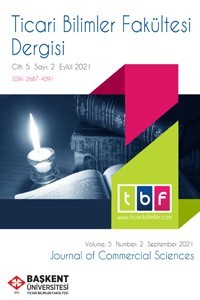OU, Vasicek, CIR ve Hull-White Modellerine Aktüeryal Uygulamaları Üzerinden Kısa Bir Bakış
Ornstein-Uhlenbeck modeli, Vasicek modeli, Cox-Ingersoll-Ross modeli, Hull-White modeli.
A Brief Look at OU, Vasicek, CIR and Hull-White Models Through Their Actuarial Applications
___
- Beekman, J. A. and Shiu, E. S. (1988). Stochastic models for bond prices, function space integrals and immunization theory. Insurance: Mathematics and Economics, 7(3), 163-173.
- Brigo, D. and Mercurio, F. (2007). Interest rate models-theory and practice: with smile, inflation and credit. Springer Science & Business Media.
- Cox, J. C., Ingersoll Jr, J. E. and Ross, S. A. (2005). A theory of the term structure of interest rates. In Theory of Valuation (pp. 129-164).
- Feller, W. (1951). Two singular diffusion problems. Annals of mathematics, 173-182.
- Grasselli, M. R., & Lipton, A. (2019). On the normality of negative interest rates. Review of Keynesian Economics, 7(2), 201-219.
- Hull, J. and White, A. (1990). Pricing interest-rate-derivative securities. The review of Financial Studies, 3(4), 573-592.
- Hull, J. and White, A. (1994). Numerical procedures for implementing term structure models I: Single-factor models. Journal of Derivatives, 2(1), 7-16.
- Hull, J. (1996). Using Hull-White interest rate trees. Journal of Derivatives, 3(3), 26-36. Jackson, H. (2015). The international experience with negative policy rates (No. 2015-13). Bank of Canada Staff Discussion Paper.
- Jamshidian, F. (1989). An exact bond option formula. The Journal of Finance, 44(1), 205-209.
- Lamberton, D. and Lapeyre, B. (2011). Introduction to stochastic calculus applied to finance. CRC press.
- Li, Y., Mao, X., Song, Y., and Tao, J. (2020). Optimal investment and proportional reinsurance strategy under the mean-reverting Ornstein-Uhlenbeck process and net profit condition. Journal of Industrial and Management Optimization.
- Ma, C., Yue, S., Wu, H., & Ma, Y. (2020). Pricing vulnerable options with stochastic volatility and stochastic interest rate. Computational Economics, 56(2), 391-429.
- Uhlenbeck, G. E. and Ornstein, L. S. (1930). On the theory of the Brownian motion, Physical Review, 36(5), 823-841.
- Vasicek, O. (1977). An equilibrium characterization of the term structure. Journal of Financial Economics, 5(2), 177-188.
- Wang, G., Wang, X., & Zhou, K. (2017). Pricing vulnerable options with stochastic volatility. Physica A: Statistical Mechanics and its Applications, 485, 91-103.
- Yoon, J. H., & Kim, J. H. (2015). The pricing of vulnerable options with double Mellin transforms. Journal of Mathematical Analysis and Applications, 422(2), 838-857.
- Zeddouk, F. and Devolder, P. (2019). Pricing of longevity derivatives and cost of capital. Risks, 7(2), 41.
- Zeddouk, F., & Devolder, P. (2020). Mean reversion in stochastic mortality: why and how?. European Actuarial Journal, 10(2), 499-525.
- Zeytun, S. and Gupta, A. (2007). A comparative study of the Vasicek and the CIR model of the short rate. Technical Report 124, Fraunhofer (ITWM).
- ISSN: 2687-4091
- Yayın Aralığı: Yılda 2 Sayı
- Başlangıç: 2017
- Yayıncı: Başkent Üniversitesi
Kuşaklar Arası Farklılığın İşgören Davranışı Üzerindeki Etkisi
Tutku TOPÇU, Erdem KIRKBEŞOĞLU
Çalışan İhtiyaçları Kurumsal Sosyal Sorumluluk Temelli İşveren Çekiciliğinde Önemli midir?
OU, Vasicek, CIR ve Hull-White Modellerine Aktüeryal Uygulamaları Üzerinden Kısa Bir Bakış
